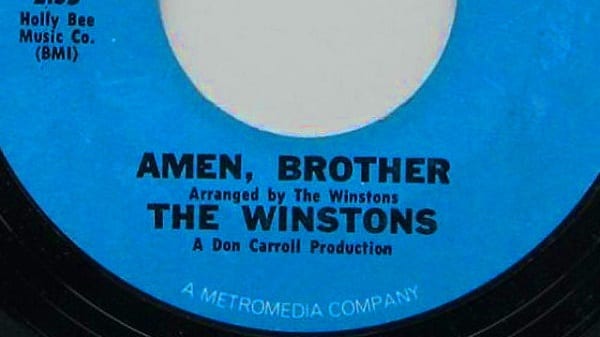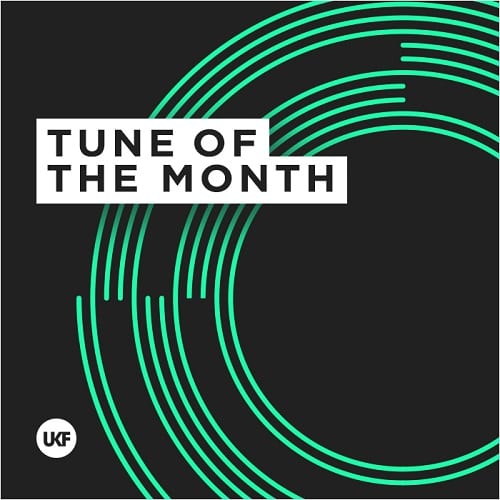The four bar drum loop known for arguably laying the foundation of D&B, hip-hop, jungle, and countless other genres, the Amen Break has recently become a hot topic of conversation following the sale of canny wood carving of the sine wave (pictured below) and the creation of a GoFundMe project aimed to finally start compensating The Winstons for their iconic contribution to music.
Originally sampled from Amen Brother, a funk update by the 1960s group The Winstons; The Amen Break reemerged after almost two decades of dormancy. Utilised for its 5.2 seconds of clean drums, Amen Brother and the Amen Break ultimately proved to be the catalyst behind a wave of sonic exploration.
Despite its widespread use, Richard L. Spencer and Gregory Coleman’s sample has remained relatively unidentified in the public eye. So this week, in honor of the Amen break, we hit the books to uncover 10 facts about the 5.2 second loop that started it all.

Once you hear it, it’s everywhere…
An omnipresent piece of pop culture’s soundscape, the Amen Break has been utilized as the sonic backdrop across all forms of advertising, marketing and commercial music. Truly independent of genre, the Amen Break can be notably cited in works from Slipknot, The Prodigy, Led Zeppelin, Nine Inch Nails, N.W.A, Squarepusher, and even the theme song to the animated sitcom Futurama. The Amen Break is the perfect example of the Baader-Meinhof phenomenon in action.
Amen Brother is The Winston’s Adaptation of Jester Hairston’s Original
Originally written for the movie Lilies Of The Field, Amen was ultimately popularized by The Impression’s folk gospel record of the same name and then adapted once more to create The Winston’s Amen Brother.
It was actually the B-side to a GRAMMY Award winning single
Amen Brother was originally released as the B-side to the 45RPM 7-inch vinyl single Color Him Father in 1969, which went on to win The Winstons a GRAMMY for best R&B song the following year.
https://www.youtube.com/watch?v=SumPJuImdPI
The Amen re-emerged on Breakbeat Lenny’s Volume 1 of Ultimate Breaks and Beats
Ultimate Breaks and Beats (UBB) was a series of compilation albums released from 1986 to 1991 curated by Louis ” BreakBeat Lou” Flores. Featuring tracks that included many popular drum breaks that eventually became some of the most notable foundation beats such as the Apache break by The Incredible Bongo Band.
Way back on volume 1, the beat that had DJs and producers experimenting across the globe was, of course, the Amen Break.
It’s one of the tools behind the development of hip-hop… No big deal
With the advent of the sampler and turntable in the 1980s, artists resuscitated the 4 bar drum loop encouraged by the new found ability to cut, rearrange and ultimately contextualize each component of the break to create a completely new and unique composition. The Amen’s “clean” nature, made it the perfect candidate for experimentation, and the result has made lasting effects on pop culture’s sonic paradigm to this very day.
It also played a pivotal role in the development of jungle
Similar to hip-hop, by splicing the original 4 bar loop into each individual components: the snare, bass drum, hi-hats and crash symbol, the Amen break was effectively and more experimentally restructured to become the core of yet another new genre of music. Blending elements of reggae, heavy bass and high speed break beats, the result was the creation of jungle.
It helped The Prodigy achieve their first number one
Firestarter, the debut single from The Prodigy’s third album, was bolstered by the Amen Break and helped the group achieve their first number-one single on the UK Singles Chart…
Even David Bowie has embraced the Amen Break
As the Amen Break began to thrive in the underground electronic scene and hip-hop, UK songwriter, multi-instrumentalist and all-round legend David Bowie took his first stab at incorporating the break into one of his records; Little Wonder.
The most championed record off of his 1997 album, Earthling, Little Wonder utilised the tenants popularizing electronic acts such as The Prodigy, and transformed tools within the context of the pop culture standard.
In addition to being heavily bolstered by the Amen Break, the lyrics of Little Wonder also rather inventively allude to all seven of the dwarfs from Walt Disney’s classic film, Snow White. Despite being the crowd favorite off of the album, David Bowie and the Amen Break failed to break the top 10 of the UK charts, achieving a peak charting position of 14 throughout the year.
https://www.youtube.com/watch?v=_9gc7AWzMoY
It’s speculated to follow Ancient Greece’s Golden Mean
Despite its audible impact on music, author and mathematician Michael S. Schneider, has proposed that the Amen Break has been so instrumental in the development of music because it has properties of the geometric Golden Mean… The ancient Greek philosophy describing the desirable middle between two extremes, the essence of truth and beauty.
While it’s an interesting theory, there’s also a very strong counter-argument. Since its original publish date, Michael Schneider’s speculator hypothesis of the Amen Break following the Golden Mean has been thoroughly investigated. Studies continue to question the integrity of Schneider’s analysis. For a deeper read into the counterpoint of Mr. Schneider’s hypothesis read more here.
It highlights the dramatic shift in intellectual-property rights in the music industry
Now, on any given day in electronic music, it is not uncommon to encounter at least one DMCA takedown or broken link due to copyright infringement. However, since its original release in 1969 and continued universal presence across all forms of music, the creators of the Amen Break have never received royalties or controlled the use of their sample. In many ways the Amen break initiated the necessary paradigm shift of controlling and monitoring plagiarism within the music industry; however it’s stifling to imagine that if this immortal sample had been controlled, D&B, hip-hop and countless other sample based genres of music would not exist in the same sense that they do today.


